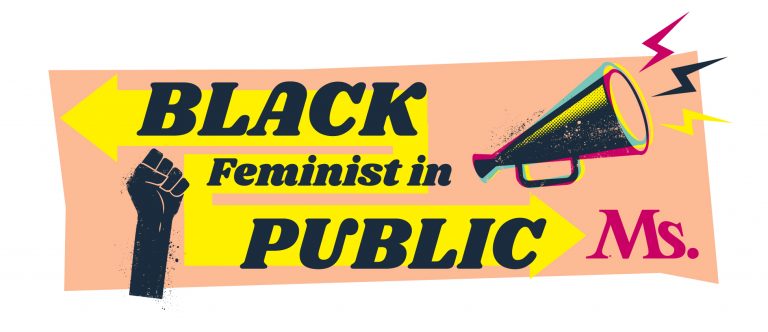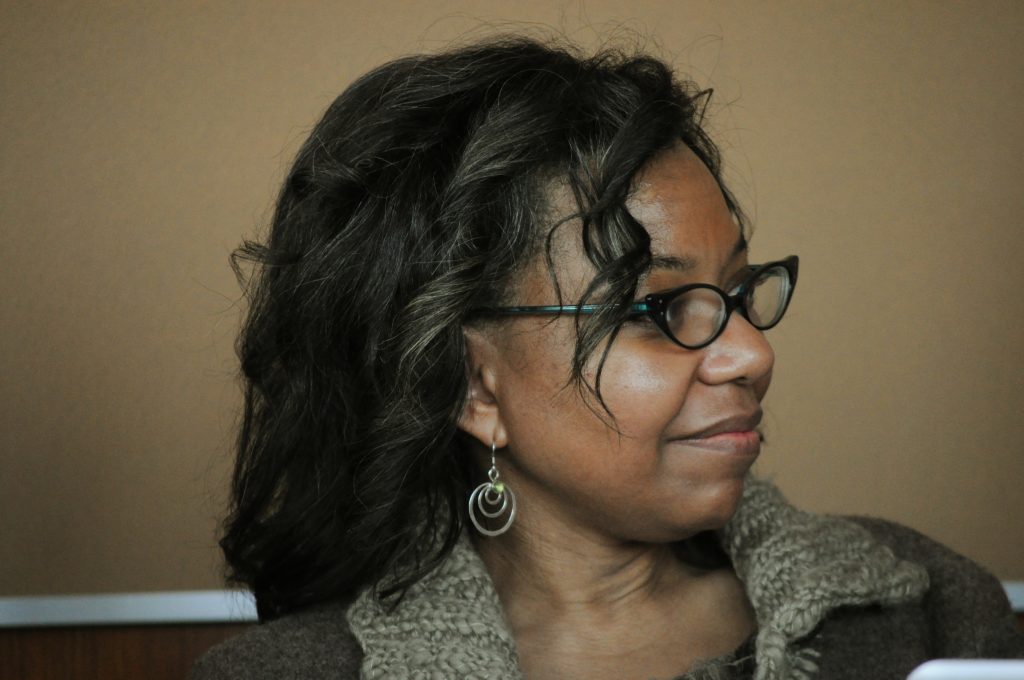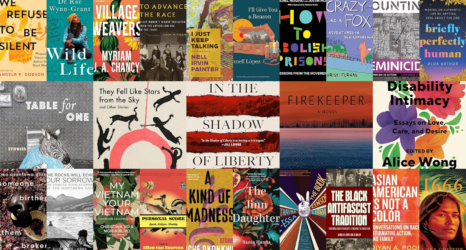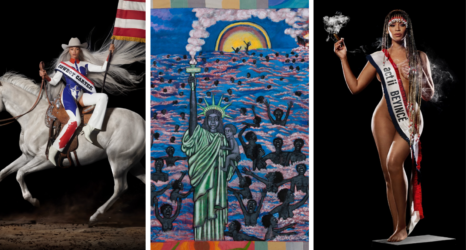
Black Feminist in Public is a series of conversations between creative Black women and Janell Hobson, a Ms. scholar whose work focuses on the intersections of history, popular culture and representations of women of African descent.
As the month of June, also known as “Black Music Appreciation Month,” comes to an end, the Black Feminist in Public series will highlight the significant intellectual work of Daphne A. Brooks.
The Yale University professor has contributed scholarship on Black performance and music studies, with a focus on Black women’s musicality. Her most recent book, Liner Notes for the Revolution: The Intellectual Life of Black Feminist Sound, was published earlier this year with Harvard University Press and explores the legacy of Black feminist critics and music artists who archived and documented their own intellectual engagements with sound culture.
Ms.’s Janell Hobson spoke to Brooks about her latest offering.

Janell Hobson: I remember you working on this project since you submitted an article on Beyoncé and Mary J. Blige for the Meridians issue on hip-hop and popular music that I was co-editing back in 2008.
Daphne A. Brooks: Back then, I was teaching the first iteration of a class that I’ve taught many times now: Black Women in Popular Music Culture. And I taught it as an undergraduate seminar at Yale, and that coincided with doing a lot of public facing writing about intersectionality and popular music culture.
And when I started working on the book proper, so to speak, it was with the intention of transforming the book’s historical span of interrogating radical innovations of Black women musicians across different social and political outlets in the 20th and into the 21st centuries. But there was a hard pivot that I ended up making eventually, in which I realized that I had to write a book about the reason why that kind of book really didn’t exist up until this point.
Hobson: So, you wrote the book that needed to be written!
Brooks: Yes, it had to be a story about what Toni Morrison would call intellectual domination as she talks about in Playing in the Dark, and how that manifests itself in the culture, the industry and taste making institutions, archives, and award show culture. And what kind of impact that had on the ways in which we perceive and engaged with Black women’s sonic artistry.
At the same time, I wanted to be able to think through and trace the counter-hegemonic, counter-historical ways in which Black women artists and accomplished thinkers have been able to create meaning and value with regards to their work. It became a much more intricate dialectical story that I was trying to tell. But absolutely, my Beyoncé work was a seed, and she ended up being the end of the project. She’s the end of most people’s projects, right? From Lemonade, it’s the mammoth ending that is also the beginning, as Ralph Ellison would say.
Hobson: Which makes sense because she herself is such a student of the history you explore.
Brooks: Absolutely. And I’m really glad that you used the word “student” because I did really want to emphasize the ways in which these artists that I’m focusing on in this study are mindful of history, are living in and through history by way of their art.
As a scholar and a thinker and an archivist, as someone who is taking seriously the ideas and modes of critical commentary that Black studies and beyond have bequeathed to us. So, I wanted to really think through and entrust that engagement that we see and feel the artists themselves moving through in their work.
Hobson: I was reading your book during a time when we had all these televised stories about Black women music artists. I’m thinking of the miniseries about Aretha Franklin on National Geographic’s Genius and the Tina Turner documentary on HBO. What are your thoughts on these?
Brooks: Isn’t it thrilling to have a television media event in which a Black woman artist of any kind is called a genius? That’s path-breaking. We’re in a moment in which we have all of these different Black women icons of sound who have emerged in the cultural imaginary.
“Isn’t it thrilling to have a television media event in which a Black woman artist of any kind is called a genius? That’s path-breaking.”
Hobson: In your book, you mentioned the term “Black feminist sound.” Could you say more about what that is to you and what is the history of that, in terms of what makes it Black feminist and not just a Black woman sound?
Brooks: I started the book with Pauline Hopkins, who we can wrestle over what it meant for our sister freedom fighters of the late 19th and early to mid-20th century to do work that defined them as feminists.
Hobson: That particular generation of Black feminists were truly awesome.
Brooks: They were absolutely awesome. They created the conditions in which we can do the work that we’re doing right now. It’s been generations of old debates about whether or not it’s anachronistic to call them feminist or not. Along those same lines, how and when we defined what we’d identify as a feminist speech act or line of performance, one could wrestle with that as well.
But for me, I was interested in the ways that we can think about a range of sonic statements that are affirming, in terms of a complex articulation of Black women’s interiority that works in support of a larger freedom struggle of what it means to reclaim one’s body, one’s sexuality, one’s sense of entitlement to a voice in the public sphere. To being able to mount a fully and richly defined sense of self by way of sound.
For me, one can track that from the time of captivity to the present day. It’s about how we as feminist thinkers recuperate those sounds as such. Maybe I’m at odds with how some other thinkers might define what it means to articulate feminism as having some autonomous structure of intention. But as a theorist of sound studies and performance studies and literary studies, I’m interested in cultural phenomena as being able to resonate and have a life of its own beyond the architects who necessarily are producing cultural statements and cultural gestures.
That’s how I think about Black feminist sound. It’s something that we ethically have a responsibility as scholars to identify as a resonance and meaning—both in the historical moment in which a particular expressive statement emerges and that exceeds that moment.
Hobson: When you talk about Black women’s interiority, my mind immediately went to historian Darlene Clark Hine when she talks about the “culture of dissemblance.” How are you looking at the relationship between Black feminist sound and Black feminist silence?
Brooks: That’s a great question. I mean, Dr. Hine’s work has been so crucial to us as Black feminists in terms of understanding and documenting the ways in which our subjugation is embedded into the material conditions in which we exist. The ones that we navigate and the ones from which we seek to perpetually free ourselves.
I think that kind of negotiation between the histories of trauma that so often undergird the performances that lead to spectacular kinds of speech acts in the public sphere remind us of these deep entanglements. Sometimes those spectacularly audible performances are meant to be read as reparative or forms of redress, or as counter interventionist statements to that which we have historically been unable to speak. The unspeakable, as Toni would put it, in these public spaces.
So, I think your question reminds us of the ways in which we should be thinking about the audible as always inextricably linked to what is rendered as silence. Or, if we think about Kevin Quashie’s The Sovereignty of Quiet, this can also be beautifully quiet as well.
Hobson: What was most surprising to you in doing this detailed research?
Brooks: I was thrilled and yet also surprised to see the kinds of intimacies that emerged between musicians and critics—say in the archives of the great pioneering jazz musician, Mary Lou Williams, who is completely under-theorized. Mary Lou wrote extensively about her problems with critics, the ways in which she could reread the critics and identify all of the different weaknesses and pitfalls in terms of white male critics’ myopia in thinking about the complexities of Black sounds.
Hobson: Interesting. I had noticed you had also paid attention to the work of non-musicians like Pauline Hopkins but also Zora Neale Hurston.
Brooks: Zora is a huge part of the book. We’re in this exciting moment with regards to Zora Neale Hurston studies. We’re at a turning point where you have so many scholars who are thinking about her sound and all that field work that she did for the WPA in the mid to late 1930s, as well as her cinematic work.
I’d been thinking about her body of work for about a decade now. And once I heard her recordings at the Smithsonian and really sat with them, I started to think about the ways in which they produced a parallel knowledge, a dialectical knowledge to that which she was producing with her prodigious essays. I started thinking about the ways in which those essays amounted to Zora’s version of liner notes for the recordings that she was doing around the same time and that she would continue to do throughout the decade of the 1930s. I wanted to think about that dialectical play between writing alongside sound and also performing sonic artistry out in the field.
Hobson: In thinking of this history and the ways in which we’ve responded to Black women’s sound, Black feminist sound, why is it so difficult for the larger culture to recognize the genius of Black women’s sound?
Brooks: Well, it’s what folks like Hortense Spillers have reminded us. A recent DNA study of the transatlantic slave trade has brought Spillers’s arguments and that of Black feminist scholars of slavery into even sharper relief. Scientists calculated that enslaved women in the United States contributed 1.5 times more to the modern day gene pool of people of African descent than enslaved men.
What’s more, according to a New York Times story on this, in the United States, “European men contributed three times more to the modern day gene pool of people of African descent than European women did.” Christine Kenneally is the author of that article.
So, a guiding principle in my work was to try and answer the question of why and how the descendants of this terrible disruptive journey and transgenerational ordeal made radical, life affirming art. From the hold of the ship, to the cotton fields, to the kitchen. These conditions produced this brutal negation and erasure from the national imaginary. It is precisely this violence of erasure that also produced some of our most devastatingly transformative art.
“Enslaved women in the United States contributed 1.5 times more to the modern day gene pool of people of African descent than enslaved men.”
Hobson: That reminds me of Alice Walker’s “In Search of Our Mother’s Gardens,” in which she tries to trace the origins of Black women’s genius.
Brooks: It’s true. I mean, she famously has the line that I talk about in the book: “Can we imagine if these women had been muzzled for life,” right?
Hobson: Exactly!
Brooks: But it’s the fact that we’re even having a conversation in which we’re talking about the precarity and the vulnerability attached to their expression. It was a reminder of what’s at stake in their music, and also the reasons why they’re always going to be susceptible to being erased and negated and subjugated.
Hobson: Not to mention the different ways Black women get pushed out from the music industry.
Brooks: Absolutely. We know this to be true, the extent to which they are vulnerable, physically vulnerable in the studio and beyond. We have stories of that. Mary Lou Williams was actually assaulted, sexually assaulted in transit to get to the space of being able to record again. And she went ahead with the recordings. There’s the everyday perils that Black women faced, in terms of being able to protect the right to their own bodies. It’s the kind of material catastrophe that hangs over the conditions of which they make their art. And so, the book is also an invitation to think about how we ethically care for those stories and incorporate them into how we think about and theorize the music as well.
Up next:





